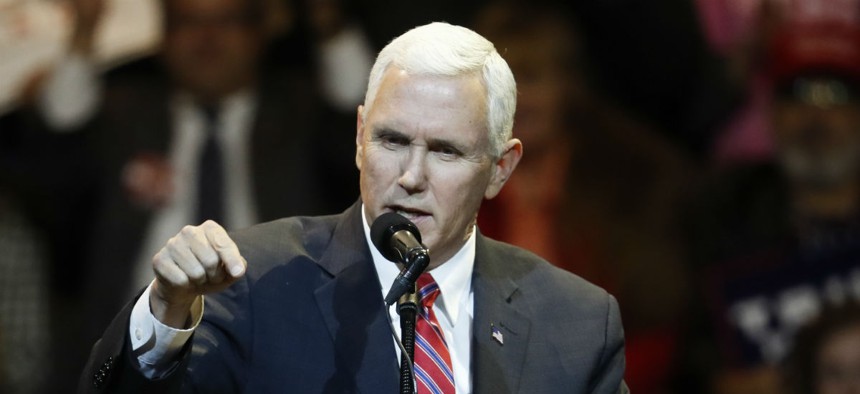
Vice President-elect Mike Pence said Sunday that Trump's process for choosing a Cabinet has brought "refreshing energy" to the transition. John Minchillo / AP
Is Trump Running the Fastest Transition in 40 Years, and Does That Matter?
Good-government observers caution that appointments are a “marathon, not a sprint.”
President-elect Donald Trump’s orchestrated and secretive process for selecting a Cabinet has brought “refreshing energy” to the transition, Vice President-elect Mike Pence said on Sunday’s ABC News “This Week.”
“He's not only bringing together a Cabinet at a historic pace for the last 40 years, he's not only assembling a legislative agenda … to move forward this country at home and abroad, but he's also been engaging the world,” Pence told George Stephanopoulos. “I think during the course of the transition eight years ago, President Obama, it's reported, spoke to 22 world leaders, and President-elect Trump has spoken to...more than 50.”
Interviews with several dedicated transition observers show that Pence is partly right, despite some early irregularities and some abrupt changes in personnel on the Trump transition team that, in accordance with this year’s new transition law, had worked for months before the election to assure a smooth hand-off.
“The rate of Cabinet picks during previous transitions is an important benchmark, but it should not be the metric used to measure the overall success of a transition,” Max Stier, president and CEO of the Partnership for Public Service, told Government Executive. “Success is whether or not President-elect Trump will be ready to govern on Day 1.”
Talks with foreign leaders in the past were coordinated through the State Department. And Trump’s delay in selecting a budget director while naming relatively quickly a United Nations ambassador (South Carolina Gov. Nikki Haley) does not jibe with the recommended priorities and schedules in the Partnership for Public Service’s “Presidential Transition Guide.”
Trump should aim to get his "White House team in place and the top 100 agency leaders confirmed shortly after Inauguration Day and the top 400 Senate confirmed leaders by the August recess," Stier said. "This process truly is sprinting a marathon. While it is encouraging to see President-elect Trump announce several appointments since the election, these are just a small number compared to the nearly 4,000 he will have to make.”
Dan Blair, president and CEO of the National Academy of Public Administration, said, “the Trump team certainly is moving forward at a clipped pace in naming the Cabinet positions. From my viewpoint, they are on time in naming the top tier. The issue is not whether they are one or two positions ahead on one day or a position or two behind the next. The real issue is assembling a functioning, confirmed Cabinet quickly after the inauguration.” Blair called that a “long-haul effort.”
Vetting and nominating the deputy secretaries, other agency heads, assistant secretaries, and other appointments that require Senate confirmation – “not to mention the non-career Senior Executive Service and Schedule Cs – are the real challenges for the new administration over the next nine months,” Blair said.
Towson University political scientist Martha Joynt Kumar, a longtime student of transitions, noted that in a traditional hand-off, the agency review teams are generally sequenced first before the key White House staff and Cabinet so those teams “can begin the work gathering information in the departments and agencies on the status of programs, budgets, schedules, positions and personnel.”
Simultaneously, the presidents-elect and their teams work to fill out the roster of the dozen senior White House staff and the director of OMB. “These dozen officials are important because the top White House staff form a president’s decision-making structure,” she said. “Before a president can make decisions, he ideally has in place a framework that takes into account what constitutes a mature decision, who he wants and needs to hear from, what information he requires and from who, and what alternative courses of action there are as well as previous actions in the decision areas.”
Having an OMB director in place early is also vital because of the February budget deadline as well as the traditional presidential speech to a joint session of Congress, Kumar added.
On Cabinet members, “except for George W. Bush, Trump is ahead of his predecessors in the number of Cabinet positions he has filled,” she said, noting that the 2000 recount delayed Bush’s actions well into December. By just after Christmas 2000, Bush had named 11 of his 14 Cabinet members; at a comparable point, Obama had named six and Trump eight.
Trump has named four of the top 12 White House office and OMB posts, yet by the same time, Obama had named all but one, Kumar reported. Both presidents Reagan and Clinton were also behind on naming White House staff. “Clinton said that he made a mistake by focusing first on the Cabinet rather than the White House staff, most of whom were announced on January 14,” Kumar’s research shows.
This year, Trump’s agency landing teams “entered the agencies and departments later than the Obama people did. But a mitigating factor here is that the 2015 Presidential Transitions Improvements Act requires the government to begin transition information gathering work for candidates and for the president-elect beginning with the appointment of the White House Transition Coordinating Council and the Agency Transition Directors Councils, which by law now form beginning six months prior to the election,” Kumar added. “Thus, they have ready for the landing teams a great deal of the information that the department and agency teams want to gather.”







